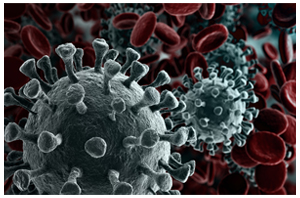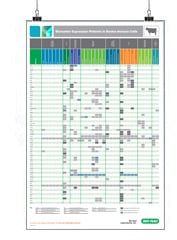SARS‐CoV‐2 in Mink

- On This Page
- SARS-CoV-2
- SARS-CoV-2 origins
- Species infectivity
- SARS-CoV-2 in mnk
- SARS-CoV-2 in mink antibody range
- References
s
Biomarker Expression Patterns Posters
s
Sign up to Our Emails

Be the first to know when we launch new products and resources to help you achieve more in the lab.
s
SARS-CoV-2
 In late 2019, a viral pneumonia was spreading rapidly in Wuhan, China. By December, it had been identified as SARS-CoV-2 and linked to a seafood and live animal market (Zhu et al. 2020). A year later, a series of candidate vaccines have been developed, several with regulatory approval for use and are being rolled out. However, the worldwide death toll (Dong et al. 2020) is heading towards 1.8M and still climbing. While the human health aspect of COVID-19 caused by SARS-CoV-2 receives the full thrust of research and healthcare efforts, investigations have shown that several species can be infected by the virus.
In late 2019, a viral pneumonia was spreading rapidly in Wuhan, China. By December, it had been identified as SARS-CoV-2 and linked to a seafood and live animal market (Zhu et al. 2020). A year later, a series of candidate vaccines have been developed, several with regulatory approval for use and are being rolled out. However, the worldwide death toll (Dong et al. 2020) is heading towards 1.8M and still climbing. While the human health aspect of COVID-19 caused by SARS-CoV-2 receives the full thrust of research and healthcare efforts, investigations have shown that several species can be infected by the virus.
SARS-CoV-2 Origins
Initially, the greatest sequence identity to SARS-CoV-2 was found in closely related coronaviruses from bats (Zhou et al. 2020) and pangolins (Lam et al. 2020). However, phylogenetic dating has indicated that SARS-CoV-2 diverged from bat coronaviruses decades ago, meaning that the actual animal reservoir of SARS-CoV-2 has not been discovered yet (Boni et al. 2020). What has been demonstrated is that SARS-CoV-2 can infect a variety of species.
Wide Species Infectivity
Experimental infections were possible in: rhesus macaques (Munster et al. 2020), cynomolgus macaques (Rockx et al. 2020), African green monkey (Woolsey et al. 2020), dogs (Shi et al. 2020), cats (Shi et al. 2020), ferrets (Shi et al. 2020, Richard et al. 2020), hamsters (Sia et al. 2020), rabbits (Mykytyn et al. 2020), and fruit bats (Schlottau et al. 2020). However, experimental infections were not successful in pigs and chickens (Shi et al. 2020, Schlottau et al. 2020). It seems that poultry species (turkeys, ducks, quail, and geese) are resistant to SARS-CoV-2 (Suarez et al. 2020). Natural infections have been found in dogs (Sit et al. 2020) and cats (Zhang et al. 2020), as well as tigers and lions (McAloose et al. 2020).
SARS-CoV-2 in Mink
The natural infection of animals that garnered the largest attention and impact was the spread of SARS-CoV-2 in mink. The first outbreak occurred in the Netherlands in April and May 2020 (Oreshkova et al. 2020, Molenaar et al. 2020). Others followed in Spain, USA, Sweden, and Italy. A much larger outbreak spread through the Danish mink population, eventually spreading so far and reinfecting humans, leading the Danish government to pass legislation putting a nationwide cull into action.
In Denmark, 300 human cases were linked to the virus found in mink. Interesting aspects of the viral samples sequenced showed that these SARS-CoV-2 variants had mutations (Y453F) in the spike protein. A further infection cluster had three amino acid substitutions and two deletions in the spike protein. Fortunately, the virus appears to have stayed contained, not spread geographically, and may even have been eliminated (Mallapaty 2020). Additionally, these mutations are not considered to have increased the infectivity or caused changes in morbidity and mortality of the virus.
The outbreaks in mink populations show that much research remains to be done to fully elucidate the biology of SARS-CoV-2. These outbreaks raise the specific need for a better understanding of mink immunology, for animal welfare reasons but also as potential model animals for translational medicine. Bio-Rad, the leading veterinary antibody supplier, offers a range of antibodies cross-reactive to mustelids, listed in the table below.
In addition to our catalog of antibodies for COVID-19 research use, we offer a wide range of useful buffers, reagents, and accessory products:
SARS-CoV-2 in Mink Antibody Range
| Description | Target | Format | Clone | Applications | Citations | Code |
|---|
References
- Boni MF et al. (2020). Evolutionary origins of the SARS-CoV-2 sarbecovirus lineage responsible for the COVID-19 pandemic. Nat Microbiol. 5(11), 1408-1417.
- Dong E et al. (2020). An interactive web-based dashboard to track COVID-19 in real time. Lancet Infect Dis. 20(5), 533-534.
- ECDC (2020). Rapid risk assessment: detection of new SARS-CoV-2 variants related to mink. https://www.ecdc.europa.eu/sites/default/files/documents/RRA-SARS-CoV-2-in-mink-12-nov-2020.pdf (accessed 30//11/2020)
- Lam TT et al. (2020). Identifying SARS-CoV-2-related coronaviruses in Malayan pangolins. Nature. 583(7,815), 282-285.
- Mallapaty S. (2020). COVID mink analysis shows mutations are not dangerous - yet. Nature. 587(7,834), 340-341.
- McAloose D et al. (2020). From people to panthera: natural SARS-CoV-2 infection in tigers and lions at the Bronx Zoo. mBio. 11(5), e02220-20.
- Molenaar RJ et al. (2020). Clinical and pathological findings in SARS-CoV-2 disease outbreaks in farmed mink (Neovison vison). Vet Pathol. 57(5), 653-657.
- Munster VJ et al. (2020). Respiratory disease in rhesus macaques inoculated with SARS-CoV-2. Nature. 585(7,824), 268-272.
- Mykytyn AZ et al. (2020). Susceptibility of rabbits to SARS-CoV-2. bioRxiv 2020.08.27.263988
- Oreshkova N et al. (2020). SARS-CoV-2 infection in farmed minks, the Netherlands, April and May 2020. Euro Surveill. 25(23), 2001005.
- Richard M et al. (2020). SARS-CoV-2 is transmitted via contact and via the air between ferrets. Nature Commun. 11(1), 3,496.
- Rockx B et al. (2020). Comparative pathogenesis of COVID-19, MERS, and SARS in a nonhuman primate model. Science. 368(6,494), 1,012-1,015.
- Sia SF et al. (2020). Pathogenesis and transmission of SARS-CoV-2 in golden hamsters. Nature. 583(7,818), 834-838.
- Shi J et al. (2020). Susceptibility of ferrets, cats, dogs, and other domesticated animals to SARS-coronavirus 2. Science. 368(6494), 1,016-1,020.
- Sit T et al. (2020). Infection of dogs with SARS-CoV-2. Nature. 586(7,831), 776-778.
- Schlottau K et al. (2020). SARS-CoV-2 in fruit bats, ferrets, pigs, and chickens: an experimental transmission study. Lancet Microbe. 1(5), e218-e225.
- Suarez DL et al. (2020). Lack of susceptibility to SARS-CoV-2 and MERS-CoV in poultry. Emerg Infect Dis. 26(12), 3,074-3,076.
- Woolsey C et al. (2020). Establishment of an African green monkey model for COVID-19. bioRxiv. 2020.05.17.100289.
- Zhang Q et al. (2020). A serological survey of SARS-CoV-2 in cat in Wuhan. Emerg Microb & Infecti. 9(1), 2,013-2,019.
- Zhou P et al. (2020). A pneumonia outbreak associated with a new coronavirus of probable bat origin. Nature. 579(7,798), 270-273.
- Zhu N et al. (2020). A novel coronavirus from patients with pneumonia in China, 2019 N Engl J Med. 382(8), 727-733.



